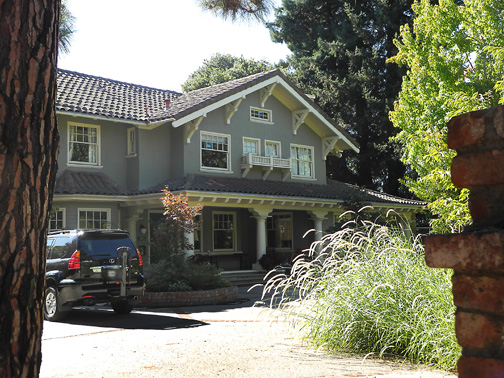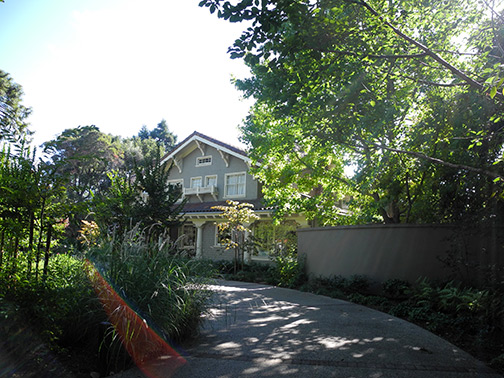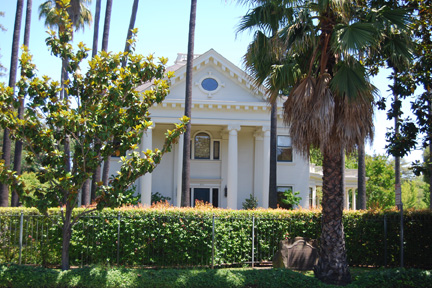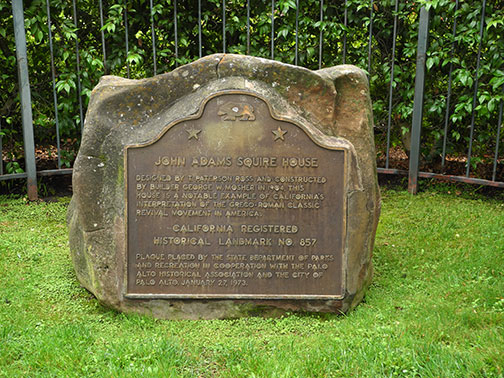 Palo Alto Stanford Heritage
Palo Alto Stanford Heritage  |
 |
Albert T. De Forest, a descendant of Roger Sherman, one of the signers of the Declaration of Independence, was born in Cleveland, Ohio in 1863. The early death of his father forced him to seek employment, at the age of fifteen, in the steel and wire mills. Eventually, he became secretary of the nail manufacturer, H. P. Nail Company. After a merger with American Steel and Wire, he rose to Cleveland district manager. His marriage to Lettie West in 1888 was followed by a move to San Francisco, where he was appointed manager of sales for the entire Western region. Major steel producers merged in 1901 forming the U. S. Steel monopoly. De Forest headed a subsidiary, Columbia Steel, from 1903 to 1933. Like many wealthy San Franciscans, he purchased land in Crescent Park to build an impressive house. De Forest also owned acreage south of Mayfield where he managed a dairy and fruit farm. Plans for De Forest’s Craftsman house on University Avenue were drawn up by San Francisco architect, T. Paterson Ross.
 |
 |
T. Paterson Ross (1873–1947) emigrated from Edinburgh, Scotland, to San Francisco at the age of 12. He found work in 1890 as a draftsman for architect John Gash. Fame came quickly, and by 1892 he designed the Cypress Lawn Chapel, which Architect and Engineer called “a splendid example of his early work.” By 1895 Ross formed his own firm ultimately producing over 250 commercial and residential structures. One residence, the 1904 Squire House, is a Palo Alto landmark. His 1907 designs for the Sing Chong and Sing Fat buildings determined the pagoda shaped buildings that dominate Chinatown. Ten years later, while designing the Temple of the San Francisco Shriners at 650 Geary Street, Ross, a Shriner himself, requested unsuccessfully that his name be placed on the cornerstone. Afterwards, a visiting scholar detected, chiseled in Arabic script above the temple’s entry, the following passage: “Great is Allah and Great is Ross the Architect.” Ross’s career and whimsical sense of humor were cut short by a construction site accident in October 1922. During an inspection of the Union League Club on Post Street, a wheelbarrow full of bricks fell on his head, fracturing his skull. Although he survived and lived for another 25 years, he was partially paralyzed and unable to speak. Ross died in 1947 at the age of 84.
The grand scale and intricately designed footprint of this 5,900 square foot house creates an impressive streetscape. The central section is set forward from the wing at the right. Within the central section, the 2nd floor itself overhangs the first. A low–pitched roof, intersecting gables with exposed rafters, huge decorative brackets, the clinker brick chimney and the wrap–around porch are typical Craftsman motifs. The porch is supported by Tuscan columns topped by oversized beams and exposed rafters. Above the porch are two windows opening to a decorative balcony and flanked by two casement windows with ten upper lites above a single pane. A rectangular attic window sits delicately in the pediment of the front gable.
The house is entered through an off center door in the central section. On either side of the door is a semi-hexagonal bay, one on the porch and one, separately roofed on the side wing. An elegant foyer with a coved ceiling, 20” baseboards and deep molding, leads to the staircase with its finely turned balustrade and unusual teardrop balusters. Double pocket doors at either side of the foyer open to the dining and living rooms. A brick fireplace in the living room is one of six in the house. Light bounces off the coved ceiling reflected from the wide bay windows at either end of the room. An abundance of fine woodwork is found in the dining room, with its paneled wainscot, a plate rail supported by brackets, deep baseboards and built–in window benches.
In 1984, the house was remodeled, resulting in a mixture of Craftsman and Spanish Colonial styles. The original shingled roof was tiled and the upper floor redwood shingles were stuccoed. The result, while not improving the original design, can be understood if we consider that the 1960’s boarders, who called themselves The Prince Valiant Residence Club, left the house in disrepair. The Club was reportedly the scene of Bacchanalian revelry and orgies.
Less forgivable was the removal of much of the 1952 Thomas Church landscaping on the 30,000 square foot property. Church (1902–1978) is known as “The Father of Modern California Landscaping” and based his work on classical design, stressing form, line and movement. Church created the concept of “outside rooms”, so popular today. Fortunately, he did not share our current mania for outdoor kitchens.©
PAST, August 28, 2015
| |
E-mail us at either webmaster@pastheritage.org or president@pastheritage.org.
![]() Palo Alto Stanford Heritage—Dedicated to the preservation of Palo Alto's historic buildings.
Palo Alto Stanford Heritage—Dedicated to the preservation of Palo Alto's historic buildings.
Copyright © 2015 Palo Alto Stanford Heritage. All rights reserved.